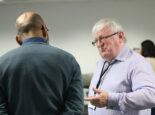A Guide to Interviewing
During the interview
Clare Eager, the Managing Director of People HR shares her four-stage guide to conducting an  interview:
interview:
The aim of an interview should be to find out relevant information regarding the candidate’s skills, knowledge and experience for the vacant role, and assess the “person fit” to the business. I recommend ensuring four stages are followed, to enable a useful interview to take place.
Stage 1: The Introduction
It is important that the structure of the interview is made clear to the candidate, and they understand what is going to happen through the interview. Welcome the candidate and thank them for their time in applying for the role. Ensure that you introduce all the people present at the interview and their role
in relation to the vacancy, this helps set the scene for the candidate and enables them to settle into the interview quicker. I would always have the line manager for the vacancy interviewing and another appropriate person.
Stage 2: Interview QuestIons
Beginning the interview with the candidate’s CV puts the candidate at ease as it is familiar information that they are being asked about. It may be that there is a time gap between roles that you want to understand further or that there are abbreviations you are not familiar with and need clarity.
Moving on, there are different types of questions that can be used in an interview. Some questions are specifically fact finding, seeking confirmation of the candidate’s knowledge. These are often closed questions, which only require a yes or no answer. Alternatively there are open questions, which require the candidate to provide fuller answers. Both open and closed questions can gain the interviewer a great deal of information, however the questions needs to be matched with what the interviewer wants to find out.
Competency-based questions are also very helpful in understanding a candidates approach to dealing with a situation. Based on the understanding that “past behaviour predicts future behaviour”, asking a question about an example when the candidate was involved in a certain situation, provides an insight into how that candidate thinks, how they responded and whether there was a positive or negative outcome. I would also ask more than one question on each area to see if they have learnt
to modify or adapt their behaviour.
There are other types of questions that help to understand the candidate’s personality and see if they would “fit” within the organisation. Examples of these types of questions include: “Tell me about the best manager you have ever worked for and what qualities did you admire?” Or, “What are your top three qualities that an employer would want?”
When asking the questions, remember it’s an interview not an interrogation. If the candidate didn’t answer the question, it could be that they didn’t understand and the question wasn’t clear. In these circumstances, rephrase the question and perhaps provide an example. Be prepared to ask follow up questions too. Consistency through questioning and across candidates is essential, to enable you to directly compare.
Stage 3: Interviewee Questions
Once your interview questions have been completed, turn the opportunity over to the candidate to ask any questions they may have. It is highly likely that they will have questions about not only the role but the organisation and the terms and conditions associated with the vacancy. Pre-empt as many of these questions as possible and have the answers ready. It isn’t necessarily a negative if the
candidate doesn’t ask any questions. This could be due to the conversation that took place during the interview and all their questions have been answered.
Stage 4: Next Steps
This is where you should inform the candidate what will happen next. Tell them when and how you expect to be getting in contact with them and what the next stage of the recruitment process would be if they were successful. Again, it is important to thank the candidate again for their time and interest
in the organisation. Even if this is not the candidate you are going to offer the role to, the level of professionalism demonstrated here will impact on how this candidate talks about your organisation to friends and colleagues in the future. Effectively marketing the organisation… Or not!
A quick word on the non verbals. Eye contact is crucial especially on greeting and departing and a firm handshake. Ensure that you show open body language throughout the interview and you are not distracted. It is the same for the candidates. Crossed arms or legs, lack of eye contact, distracted – maybe these are not positive signs of fitting into your organisation.















